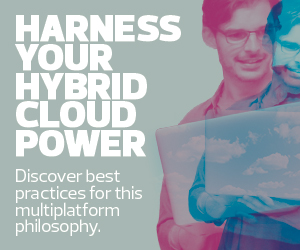The world of modern cloud architectures is very much a hybrid one. Most businesses are too complex to rely entirely on a single public cloud provider, and many use a mix of public and private clouds or on-premises infrastructure. Indeed, according to Flexera’s 2023 State of the Cloud Report, 72 percent of IT professionals and executive leaders say their organization is using a hybrid cloud approach.
Yet as hybrid cloud architectures have become more common in recent years, the management of such environments has grown more complex. In the Flexera report, 82 percent of respondents said managing cloud is a challenge, and 66 percent said it’s a challenge to manage multicloud environments.
Those challenges can lead to less agility and business value, according to Jevin Jensen, IDC’s research vice president for the intelligent CloudOps market. Because hybrid cloud is here to stay, Jevin says he encourages organizations to “embrace this complexity and look to standardize on a comprehensive solution to manage and automate their cloud environments.”
In addition to complexity, companies must also contend with skill shortages and “new financial challenges of the cloud, including how to control costs, prioritize new investments and manage the culture change of accountability for cloud spending,” Jensen says.
What Are the Most Common Challenges of Hybrid Cloud Management?
A recent article by Microsoft highlights many of the trials organizations face in managing hybrid cloud environments. These include enabling visibility into all cloud infrastructure and applications via a consolidated dashboard, as well as establishing governance for the integration of on-premises policies and updates with cloud infrastructure.
Organizations are also challenged to field an IT staff with a wide range of skills across on-premises and cloud resources. And security is an ever-present concern, with organizations facing hurdles in deploying a consistent, effective security posture without negatively affecting the user experience.
In addition to those issues, organizations also face hurdles in resource and cost optimization, IT automation and future proofing their technology, Jensen says.
“By future proofing, I mean capabilities to address the rise of cloud-native technologies like Kubernetes and AIOps,” Jensen says. “These are here today and proliferating, so IT operation teams need to get ahead of the rapid growth in these areas now. By taking advantage of AIOps, teams can be more proactive and get to root cause analysis faster.”
Click the banner to learn how your institution can benefit from a hybrid cloud environment.
What Tech Can Businesses Use to Improve Hybrid Cloud Management?
Organizations can turn to a wide range of tools to assist their hybrid cloud management efforts.
For example, Cloud Foundation from VMware makes it easy for organizations to manage infrastructure and applications in the cloud using the same tools, teams, skills, policies and standards that they use in their on-premises data centers. Nutanix says that its Cloud Clusters product lets organizations leverage a hybrid multicloud platform to run applications in private or multiple public clouds, all operated as a single cloud.
The goal is to let IT operators seamlessly manage and migrate virtual machines, containers and applications, giving them greater flexibility and reducing costs.
Such tools empower organizations to address the complexity of hybrid cloud technology so IT can continue to be agile and deliver business benefits, Jensen says. Other benefits include “overcoming the skills shortage with automation, providing guardrails to ensure cloud investments are appropriate and prioritized correctly, and tool consolidation.”
DIVE DEEPER: Discover the basic steps to optimize your organization’s hybrid cloud environment.
IT leaders need to address hybrid cloud management challenges now because the hybrid nature of their cloud environments will only continue to grow, Jensen says.
“Many of these tools provide cost optimization and reporting for accurate chargebacks, enabling the FinOps teams to make better decisions and forecast cloud spending,” he says. “Visibility and analytics are critical to IT operations. Adding AI to day-two monitoring means quicker resolution when incidents occur.”
As organizations create new workloads to support their digital business, IT teams can use a hybrid cloud platform to “select the best location to run a specific workload based on the business’s performance, cost, compliance and resilience requirements — all in an automated manner,” Jensen says.











